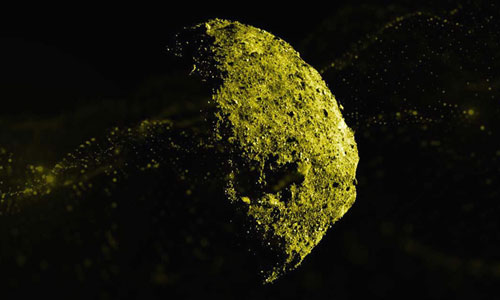Asteroid diameter of 500m spew rocks into space
Thanks to the NASA spacecraft, scientists observed material eruptions of hundreds of small stones of the asteroid Bennu.
NASA's OSIRIS-Rex spacecraft has been orbiting the asteroid Bennu since December 2018, about 160 million kilometers from the Sun. During the observation of Bennu, scientists discovered a mysterious phenomenon. It is this asteroid diameter of about 500m that often spits out small stones.

Bennu asteroid spewed material into space.(Photo: Futurism).
In the study published in Science last week, the scientists focused on describing the three largest eruptions that took place on January 6, January 19 and February 11. The strongest eruption was on January 6, OSIRIS-Rex observed about 200 stones fired. They move at an average speed of three meters per second, ranging from 2-10cm.
Three eruptions occurred at different locations on the asteroid surface. One happened in the southern hemisphere and two were near the equator. The venue seems nothing special. The time for three spraying sessions is noon. After the eruption, the rocks will fly around for a few days and then fall back to the asteroid surface, or fly into space.
"Among the many surprises Bennu brought about, the phenomenon of the rock eruption made us extremely curious. We have been studying this mystery for the past few months. This is a great opportunity to understand more about the workings of asteroids, " said Dante Lauretta, an expert at the University of Arizona.
"No one has ever observed an asteroid operating at such a close distance. Before that, the traditional notion was that the asteroid didn't change much," said Carl Hergenrother, an astronomer at the University of Arizona.
Scientists are trying to understand the cause of matter spraying. One theory is that Bennu may have erupted small debris after the collision. According to another theory, the surface temperature of Bennu fluctuated greatly, causing rocks to be splashed during surface cracking, or water vapor to create greater pressure, eventually causing stones to shoot out from cracks and holes.
- The latest images of asteroids may strike Earth
- NASA spacecraft approached the ancient planet Bennu
- The terrifying asteroid is about to hover near Earth
- A 2,000-meter asteroid could crash into Earth in the future
- Scientists study building space stations inside an asteroid
- Asteroids capable of impacting 2,700 million tons of TNT can attack the Earth
- New discoveries about Ryugu asteroid near Earth
- The biggest asteroid in the year is rushing towards Earth
- Comet: Assassin kills the dinosaurs
- Video: NASA ship borrowed Earth's force to soar to the asteroid
- Owl 'compulsive surgery' from space
- Nearly 600 meters asteroid will fly over Earth next week
- Asteroid Vesta 'very similar to the Earth
- 2012 Asteroid BX34 almost collided with the Earth
 Van Allen's belt and evidence that the Apollo 11 mission to the Moon was myth
Van Allen's belt and evidence that the Apollo 11 mission to the Moon was myth The levels of civilization in the universe (Kardashev scale)
The levels of civilization in the universe (Kardashev scale) Today Mars, the sun and the Earth are aligned
Today Mars, the sun and the Earth are aligned The Amazon owner announced a secret plan to build a space base for thousands of people
The Amazon owner announced a secret plan to build a space base for thousands of people